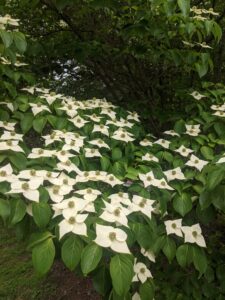Flora Fridays – June 14, 2024
go.ncsu.edu/readext?1009045
en Español / em Português
El inglés es el idioma de control de esta página. En la medida en que haya algún conflicto entre la traducción al inglés y la traducción, el inglés prevalece.
Al hacer clic en el enlace de traducción se activa un servicio de traducción gratuito para convertir la página al español. Al igual que con cualquier traducción por Internet, la conversión no es sensible al contexto y puede que no traduzca el texto en su significado original. NC State Extension no garantiza la exactitud del texto traducido. Por favor, tenga en cuenta que algunas aplicaciones y/o servicios pueden no funcionar como se espera cuando se traducen.
Português
Inglês é o idioma de controle desta página. Na medida que haja algum conflito entre o texto original em Inglês e a tradução, o Inglês prevalece.
Ao clicar no link de tradução, um serviço gratuito de tradução será ativado para converter a página para o Português. Como em qualquer tradução pela internet, a conversão não é sensivel ao contexto e pode não ocorrer a tradução para o significado orginal. O serviço de Extensão da Carolina do Norte (NC State Extension) não garante a exatidão do texto traduzido. Por favor, observe que algumas funções ou serviços podem não funcionar como esperado após a tradução.
English
English is the controlling language of this page. To the extent there is any conflict between the English text and the translation, English controls.
Clicking on the translation link activates a free translation service to convert the page to Spanish. As with any Internet translation, the conversion is not context-sensitive and may not translate the text to its original meaning. NC State Extension does not guarantee the accuracy of the translated text. Please note that some applications and/or services may not function as expected when translated.
Collapse ▲June Roadside Flora
Kousa dogwood – Cornus kousa
While a boy scout, one of my favorite sights on campouts were dogwood blooms poking through the understory and forest borders. This native flowering dogwood, Cornus florida, is our state flower and thrives in shaded environments. It’s cousin from Asia, Cornus kousa, is a much more resilient choice to plant in sunny southern landscapes. It is resilient in sunny locations, standing out with its deep green leaves and cream white to pink blooms. Grow this specimen in acidic, well drained soil. It is somewhat drought tolerant once established and will not tolerate waterlogged soil.This plant can also be trimmed back and grown as a shrub.This tree has unique features year round. Starting with colorful blooms in the spring, deep green foliage in the summer turning purple-orange in the fall, and finally its peeling bark is attractive to the eye in winter.
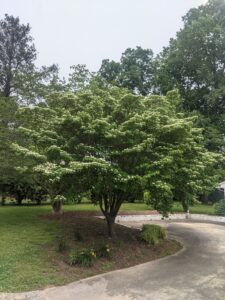
Cornus kousa as a specimen plant
Mealy collic root – Aletris farinosa
This plant can be easily missed when traveling across Montgomery County. Mealy colic-root, Aletris farinosa, is a native plant found in moist organic soils. In our region, this includes pine flatwoods, seepage bogs, mafic fens, upland woodlands, and roadsides. This perennial spreads by underground rhizome, and each summer produces a white spike inflorescence that can be over 3 feet tall. For those following Flora Fridays, it looks similar to Spiranthes orchids from a distance. When I visited the site, there was a buzz of insect activity in the air. Its flowers provide ample forage for pollinator insects, as seen in the below pictures. True to its name, upon close inspection one can see the individual flowers are quite mealy, or granular and bumpy.
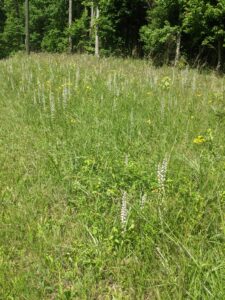
Aletris farinosa in a roadside superbloom
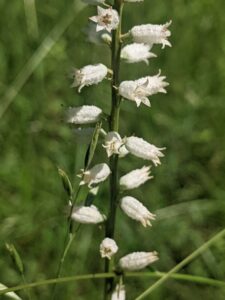
Aletris farinosa flower close up
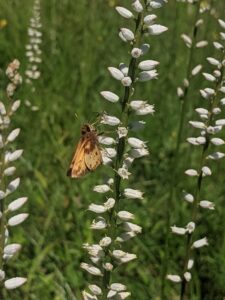
Aletris farinosa visited by a native skipper
We hope you have enjoyed this edition of Flora Fridays! I know I did. Please consider leaving feedback in the box below. At Extension, we are here to listen to and address your needs.
Check out past Flora Fridays.





